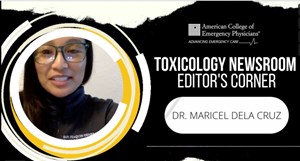
The End of DCPA (dimethyl tetrachloroterephthalate)
Author: Stella C Wong, DO
Assistant Professor of Emergency Medicine
Medical Toxicologist
Emory University School of Medicine
The U.S. Environmental Protection Agency (EPA) Announcement
On August 6, 2024, EPA issued Emergency Order to suspend all registrations and use of the pesticide dimethyl tetrachloroterephthalate (Dacthal or DCPA) under the Federal Insecticide, Fungicide and Rodenticide Act (FIFRA). This is the first time in 40 years that the EPA has taken such emergency action. The Office of Chemical Safety and Pollution Prevention Assistant Administrator Michal Freedhoff said, “It’s EPA’s job to protect people from exposure to dangerous chemicals. In this case, pregnant women who may never even know they were exposed could give birth to babies that experience irreversible lifelong health problems. That’s why for the first time in almost 40 years the EPA is using its emergency suspension authority to stop the use of pesticides.” 1
DCPA History
DCPA was manufactured by a U.S. manufacturer named Fermenta Plant Protection Company. It was first registered for use in the United States in 1958 and was sold under the trade name Dacthal. 2,3 ISK Biosciences (formerly named Fermenta Plant Protection Company) discontinued DCPA production in 1998 however American Vanguard Corporation (AMVAC) restarted the production of DCPA in 2001. 4, 5
What is DCPA?
DCPA (also known as chlorthal-dimethyl) is a herbicide primarily use to control weeds on brussels sprouts, onions, broccoli, and cabbage. The structure is a chlorinated benzoic acid. DCPA disrupts formation of microtubule in exposed cells which causes abnormal cell division. DCPA has two toxic contaminants, 2,3,7,8-tetrachlorodibenzo-p-dioxin (2,3,7,8-TCDD) and hexachlorobenzene (HCB). 1,2
DCPA Acute Toxicity
At the time DCPA’s registration standard was issued in 1988, only 1 (a skin sensitization test in guinea pigs), out of 6 acute toxicity tests was completed. The other five tests, such as dermal toxicity, oral toxicity, inhalation toxicity, eye irritation, and skin irritation, were not completed. 2,3
In 1998, DCPA was classified as Toxicity Category IV (practically non-toxic) for acute dermal irritation and oral toxicity. It was classified as Toxicity Category III (slightly toxic) for inhalation, dermal irritation and eye irritation.6
DCPA Chronic Toxicity
In a 1963 rat study, DCPA was found to cause excessive thyroid growth, liver abnormalities, accumulation of iron in the spleen (in females), increased adrenal gland weight (in females) and increased kidney weights (in males). 2,3 2,3,7,8-TCDD a toxic contaminant of DCPA, has been found to cause thymus atrophy, liver damage, weight loss, disfiguration of skin, cancer, birth defects, reproductive failure and immune system dysfunction in animals. 2,7 HCB, another contaminant of DCPA, has been found to cause short stature, liver damage, skin lesions, muscle weakness, arthritis in hands and osteoporosis in humans. 2,8. DCPA has been classified as a possible human carcinogen (Group C) by the EPA.6
Why did EPA emergently suspend the use of DCPA?
The suspension is secondary to serious health risks to unborn fetuses. The most concerning health risks are to an unborn fetus. According to the EPA, fetal exposure could affect fetal thyroid hormone levels, which may lead to impaired brain development, decreased IQ, impaired motor skills, and low birth weight, with some of these effects being irreversible. Another concern is that the environmental DCPA levels remain unsafe for 25 days after treatment; however, the product labels only recommend restricting entry to DCPA-treated areas for 12 hours, potentially exposing individuals to potentially toxic exposures. 1
In 2013, the EPA requested AMVAC Chemical Corporation (manufacturer of DCPA) to submit over 20 studies to support DCPA registration. The requested studies included effects of DCPA on thyroid development in humans, including in adults, children, and fetuses. The submission was due by January 2016; however, the EPA found that data that were submitted between 2013 and 2021 to be insufficient, and the thyroid study was not submitted.1
In August 2022, AMVAC submitted the required thyroid study to the EPA after the EPA issued a Notice of Intent to Suspend in April 2022. However, AMVAC continued to fail to submit other outstanding data. The data submission suspension was lifted in November 2023 after AMVAC submitted the required data. In December 2023, AMVAC voluntarily canceled DCPA use on turf; however, risks from other uses remained.1
According to the Office of Chemical Safety and Pollution Prevention on March 27, 2024, EPA released an Occupational and Residential Exposure (ORE) assessment of DCPA exposure in May 2023 after AMVAC submitted the thyroid study data. AMVAC proposed the following as risk mitigation strategies:9
- “Designate DCPA products as Restricted Use Products to aid in recordkeeping/enforcement
- Remove wettable powder formulations from the market
- Retain only limited uses of DCPA: onions, radishes, and Brassicas except turnips
- Reduce maximum single application rates for remaining uses
- Reduce maximum annual application rate as compared to the rates currently appearing on labels
- Allow application only around the time of seeding or transplanting, including applications made over the top of transplants; prohibit later season applications
- Prohibit aerial application
- Prohibit application with hand-held equipment
- Require mechanical incorporation/watering-in of product
- Require closed mixing/loading systems for people who mix and load DCPA products, and enclosed cabs for applicators (categorized as Engineering Controls)
- Require maximum Personal Protective Equipment (PPE) for handlers
- Implement limits on the amount of DCPA that can be handled by mixer/loaders and applicators in a single day (daily acreage limits or limits on amount of product handled)
- Require PPE for post-application workers
- Require re-entry restrictions by crop and post-application activity
- Require mandatory coarse or coarser spray droplet size spectrum and low boom height (18”)
- Require a buffer of 150 feet between treated areas and residential areas”
However, the EPA did not find the risk mitigation proposal adequate. The agency has determined that the re-entry restrictions to perform post DCPA application activities need to be 9 to 27 days; however, workers are typically required to re-enter the fields within the first week. The post-application risks remain a concern for the EPA.
What happened next?
On Aug 19, 2024, the EPA received a letter from AMVAC expressing the intent to cancel all DCPA-containing products domestically in the United States and internationally. On Aug 28, 2024, the EPA initiated cancelling all DCPA-containing products. This suspension prohibits selling, shipping, or distributing any DCPA-containing products. AMVAC is working closely with the EPA on a program for existing DCPA products to be returned. The EPA regularly communicates with AMVAC regarding the status of the return program.10
On October 22, 2024, the EPA announced the cancellation of all DCPA or Dacthal-containing products under the Federal Insecticide, Fungicide, and Rodenticide Act (FIFRA). The final cancellation prohibits individuals/companies from selling or distributing DCPA-containing products and prohibits the use of the existing DCPA-containing products.11
References
- EPA Issues Emergency Order to Stop Use of Pesticide Dacthal to Address Serious Health Risk. Last Updated on August 6, 2024.
- Cox, C. DCPA (Dacthal). Journal of Pesticide Reform. Fall 1991;11(3):17-20.
- S. Environmental Protection Agency. Office of Pesticide and Toxic Substances. Office of Pesticide Programs. 1988. Pesticide fact sheet (DCPA). Washington, D.C.
- Dimethyl tetrachlortoterephthalate. Last updated on August 18, 2024.
- Chapter 4: DCPA Mono- and Di-Acid Degradates. A chapter from: Regulatory Determinations Support Document for Selected Contaminants from the Second Drinking Water Contaminant Candidate List (CCL 2). EPA Report 815-R-08-012.
- EPA R.E.D. FACTS. DCPANovember 1998.
- Silbergeld, EK and Gasiewiz TA. Commentary: Dioxins and the Ah receptor. Amer. J. of Industrial Med. 1989;16: 455-474.
- U.S. Department of Health and Human Services. Agency for Toxic Substances and Disease Registry. 1990. Toxicological profile for hexachlorobenzene. Washington, D. C.
- EPA’ s response to AMVAC’s DCPA risk mitigation proposal. file:///Users/n137221/Downloads/EPA-HQ-OPP-2011-0374-0112_content.pdf. Office of Chemical Safety and Pollution Prevention. Washington, D. C. March 27, 2024.
- EPA Announces Voluntary Cancellation for the Pesticide Dacthal. Last updated on August 28, 2024.
- EPA Finalizes Cancellation of the Pesticide Dacthal. Last updated on October22, 2024.



